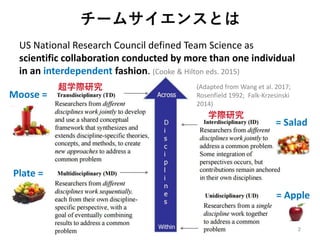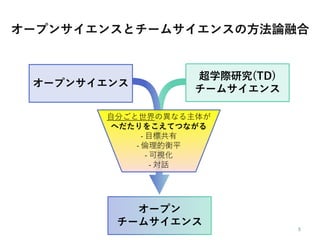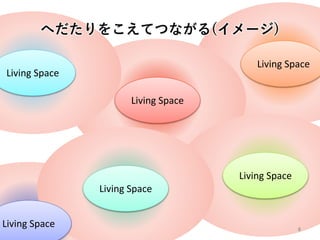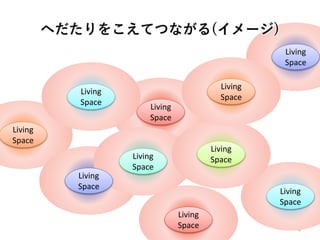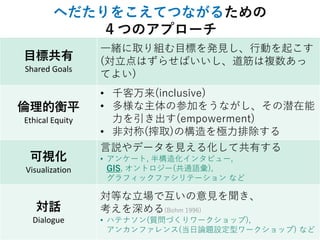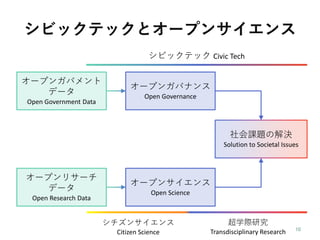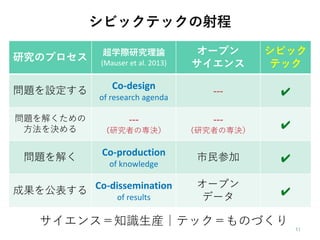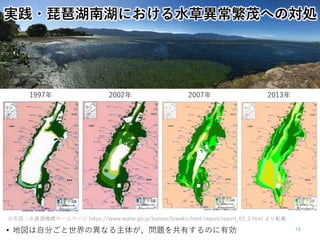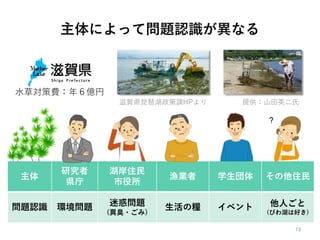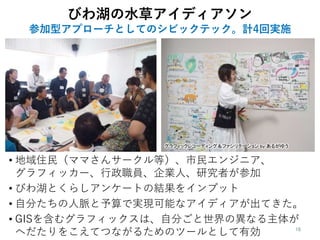チームサイエンスにおける知识融合ツールとしての骋滨厂の役割
- 1. チームサイエンスにおける知識融合ツール としてのGISの役割 近 藤 康 久 @yaskondo @RIHN_OpenTS 地理情報システム学会2018年大会企画セッション オープンxシチズンサイエンスによる市民協働と次のステップに向けて 2018年10月21日 首都大学東京
- 2. Moose = = Salad = Apple Plate = チームサイエンスとは US National Research Council defined Team Science as scientific collaboration conducted by more than one individual in an interdependent fashion. (Cooke & Hilton eds. 2015) (Adapted from Wang et al. 2017; Rosenfield 1992; Falk-Krzesinski 2014) 超学際研究 学際研究
- 3. 自分ごと世界の異なる主体が へだたりをこえてつながる - 目標共有 - 倫理的衡平 - 可視化 - 対話 オープンサイエンス 超学際研究(TD) チームサイエンス オープン チームサイエンス オープンサイエンスとチームサイエンスの方法論融合
- 4. In-between space へだたりをこえてつながる(イメージ) Living Space Living Space Living Space Living Space Living Space Living Space
- 6. へだたりをこえてつながるための 4つのアプローチ 目標共有 Shared Goals 一緒に取り組む目標を発見し、行動を起こす (対立点はずらせばいいし、道筋は複数あっ てよい) 倫理的衡平 Ethical Equity ? 千客万来(inclusive) ? 多様な主体の参加をうながし、その潜在能 力を引き出す(empowerment) ? 非対称(搾取)の構造を極力排除する 可視化 Visualization 言説やデータを見える化して共有する ? アンケート, 半構造化インタビュー, GIS, オントロジー(共通語彙), グラフィックファシリテーション など 対話 Dialogue 対等な立場で互いの意見を聞き、 考えを深める(Bohm 1996) ? ハテナソン(質問づくりワークショップ), アンカンファレンス(当日論題設定型ワークショップ) など
- 7. シビックテックとオープンサイエンス オープンガバメント データ Open Government Data オープンリサーチ データ Open Research Data オープンガバナンス Open Governance オープンサイエンス Open Science 社会課題の解決 Solution to Societal Issues シビックテック Civic Tech 超学際研究 Transdisciplinary Research シチズンサイエンス Citizen Science
- 8. シビックテックの射程 研究のプロセス 超学際研究理論 (Mauser et al. 2013) オープン サイエンス シビック テック 問題を設定する Co-design of research agenda --- ?? 問題を解くための 方法を決める --- (研究者の専決) --- (研究者の専決) ?? 問題を解く Co-production of knowledge 市民参加 ?? 成果を公表する Co-dissemination of results オープン データ ?? サイエンス=知識生産|テック=ものづくり
- 9. 実践?琵琶湖南湖における水草異常繁茂への対処 分布図:水資源機構ホームページ https://www.water.go.jp/kansai/biwako/html/report/report_03_2.html より転載 1997年 2002年 2007年 2013年 ? 地図は自分ごと世界の異なる主体が、問題を共有するのに有効
- 10. 主体によって問題認識が異なる 主体 研究者 県庁 湖岸住民 市役所 漁業者 学生団体 その他住民 問題認識 環境問題 迷惑問題 (異臭?ごみ) 生活の糧 イベント 他人ごと (びわ湖は好き) 水草対策費:年6億円 滋賀県琵琶湖政策課HPより 提供:山田英二氏
- 11. オープンサイエンスと超学際研究の方法論融合 びわ湖の水草問題対処にあてはめると 知識生産システムの 開放 へだたりをこえて つながる (これからの) オープンチーム サイエンス びわ湖アンケート 《FAIRデータ》 Findable, Accessible, Interoperable, Reusable 水草アイディアソン 《シビックテック》 Outcome リソース 経験をフィードバック 知識生産 Knowledge production 行動 Action Input Output Networking = KAN 研究者とエンジニア、 地域の人たちが一緒に 水草の価値転換 《自分ごと世界の拡張》 水草の異常繁茂 《現実世界の問題》 自分たちで実現可能な 仕組みをつくる 超学際研究(TD)オープンサイエンス
- 12. びわ湖とくらしについてのアンケート ? 目的:琵琶湖沿岸住民の環境に対する意 識を明らかにする。 ? 実施主体:総合地球環境学研究所 – 滋賀県琵琶湖政策課、大津市?草津市?守 山市担当課の了解のもとに実施 ? 対象:大津市(堅田以南)?草津市?守山市 の住宅30,203戸 ? 調査方式:郵送法 ? 2018年1月15日発送、1月31日締切 ? 回収通数:4,578通(回収率15.16%) ? 単純集計結果をプロジェクトウェブサイトに て公表 計画説明と結果共有にGISを使用
- 13. びわ湖の水草アイディアソン 参加型アプローチとしてのシビックテック。計4回実施 ? 地域住民(ママさんサークル等)、市民エンジニア、 グラフィッカー、行政職員、企業人、研究者が参加 ? びわ湖とくらしアンケートの結果をインプット ? 自分たちの人脈と予算で実現可能なアイディアが出てきた。 ? GISを含むグラフィックスは、自分ごと世界の異なる主体が へだたりをこえてつながるためのツールとして有効 グラフィックレコーディング&ファシリテーション by あるがゆう
Editor's Notes
- #3: Team Science is another keyword of this proposal. The US National Research Council defined Team Science as scientific collaboration, conducted by more than one individual, in an INTERDEPENDANT fashion. Team Science can be unidisciplinary and multidisciplinary, but it is necessary to higher stages of knowledge integration in interdisciplinary and transdisciplinary research. In both interdisciplinary-ID, and transdisciplinary-TD, researchers from different disciplines work jointly to address a common problem. In ID teams, joint contributions remain anchored in their own disciplines, while in TD teams, researchers from different disciplines develop a shared conceptual framework to create new approaches, usually with societal stakeholders. [click]
- #5: In other words, transdisciplinary approach is a science with society...
- #6: In short, this Core Project aims at a new research paradigm of Open Team Science by integrating Open Science and transdisciplinary Team Science. I will overview these concepts in next slides. [click]
- #18: This slide shows an example of information asymmetry in a transdisciplinary, or TD project. Regarding the overgrowth of waterweed in Lake Biwa, being studied with the Ecological Recycling Project, research experts and policy makers of the prefectural office, think it is an ecological problem. In contrast, it is a social problem for coastal residents and municipalities because they suffer from bad odor of drifted waterweed and must remove it as rubbish. Moreover, most of the unengaged public seems NOT interested in this socio-environmental issue, even though they are tax payers for that. In this case, the waterweed issue is differently understood in different socio-geographical contexts. [click]


